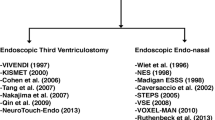Abstract
Introduction
Virtual reality simulation is a promising alternative to training surgical residents outside the operating room. It is also a useful aide to anatomic study, residency training, surgical rehearsal, credentialing, and recertification.
Discussion
Surgical simulation is based on a virtual reality with varying degrees of immersion and realism. Simulators provide a no-risk environment for harmless and repeatable practice. Virtual reality has three main components of simulation: graphics/volume rendering, model behavior/tissue deformation, and haptic feedback. The challenge of accurately simulating the forces and tactile sensations experienced in neurosurgery limits the sophistication of a virtual simulator. The limited haptic feedback available in minimally invasive neurosurgery makes it a favorable subject for simulation.
Conclusions
Virtual simulators with realistic graphics and force feedback have been developed for ventriculostomy, intraventricular surgery, and transsphenoidal pituitary surgery, thus allowing preoperative study of the individual anatomy and increasing the safety of the procedure. The authors also present experiences with their own virtual simulation of endoscopic third ventriculostomy.





Similar content being viewed by others
References
Agrawal A, Kato Y, Sano H, Kanno T (2013) The incorporation of neuroendoscopy in neurosurgical training programs. World Neurosurg 79:S15.e11–S15.e13
Balogh AA, Preul MC, Laszlo K, Schornak M, Hickman M, Deshmukh P, Spetzler RF (2006) Multilayer image grid reconstruction technology: four-dimensional interactive image reconstruction of microsurgical neuroanatomic dissections. Neurosurgery 58:ONS157–165, discussion ONS157-165
Malone HR, Syed ON, Downes MS, D’Ambrosio AL, Quest DO, Kaiser MG (2010) Simulation in neurosurgery: a review of computer-based simulation environments and their surgical applications. Neurosurgery 67:1105–1116
Robinson RALC, Apuzzo MLJ (2011) Man mind and machine: the past and future of virtual reality simulation in neurologic surgery. World Neurosurg 76:419–430
Babineau TJ, Becker J, Gibbons G, Sentovich S, Hess D, Robertson S, Stone M (2004) The "cost" of operative training for surgical residents. Arch Surg 139:366–369, discussion 369–370
Delorme S, Laroche D, DiRaddo R, Del Maestro RF (2012) NeuroTouch: a physics-based virtual simulator for cranial microneurosurgery training. Neurosurgery 71:32–42
Spicer MA, van Velsen M, Caffrey JP, Apuzzo ML (2004) Virtual reality neurosurgery: a simulator blueprint. Neurosurgery 54:783–797, discussion 797–788
Wang P, Becker AA, Jones IA, Glover AT, Benford SD, Greenhalgh CM, Vloeberghs M (2006) A virtual reality surgery simulation of cutting and retraction in neurosurgery with force-feedback. Computer methods and programs in biomedicine 84:11–18
Massie TH SJ (1994) The PHANTOM haptic interface: a device for probing virtual objects. Proceedings of the ASME Winter Annual Meeting, Symposium on Haptic Interfaces for Virtual Environment and Teleoperator Systems, Chicago
Dai JX, Chung MS, Qu RM, Yuan L, Liu SW, Shin DS (2012) The Visible Human Projects in Korea and China with improved images and diverse applications. Surgical and radiologic anatomy : SRA 34:527–534
Larsen OVHJ, Ostergard LR, Hansen KV, Nielsen H (2001) The Virtual Brain Project—development of a neurosurgical simulator. Stud Health Technol Inform 81:256–262
Kockro RA, Serra L, Tseng-Tsai Y, Chan C, Yih-Yian S, Gim-Guan C, Lee E, Hoe LY, Hern N, Nowinski WL (2000) Planning and simulation of neurosurgery in a virtual reality environment. Neurosurgery 46:118–135, discussion 135–117
Radetzky ARM, Starkie S, Davies B, Auer LM (2000) ROBO-SIM: a simulator for minimally invasive neurosurgery using an active manipulator. Stud Health Technol Inform 77:1165–1169
Lemole GM Jr, Banerjee PP, Luciano C, Neckrysh S, Charbel FT (2007) Virtual reality in neurosurgical education: part-task ventriculostomy simulation with dynamic visual and haptic feedback. Neurosurgery 61:142–148, discussion 148–149
Thomas RGJN, Delieu JM (2010) Augmented reality for anatomical education. J Vis Commun Med 33:6–15
Brown NNS, Johannsen S, Manjila S, Cai Q, Liberatore V, Cohen AR, Cavusoglu MC (2006) Virtual environment-based training simulator for endoscopic third ventriculostomy. Stud Health Technol Inform 119:73–75
Burtscher JBR, Dessl A, Eisner W, Twerdy K, Sweeney RA, Felber S (2002) Virtual endoscopy for planning neuro-endoscopic intraventricular surgery. Minimally invasive neurosurgery : MIN 45:24–31
Wolfsberger S, Neubauer A, Buhler K, Wegenkittl R, Czech T, Gentzsch S, Bocher-Schwarz HG, Knosp E (2006) Advanced virtual endoscopy for endoscopic transsphenoidal pituitary surgery. Neurosurgery 59:1001–1009, discussion 1009–1010
Luciano CBP, Lemole GM Jr, Charbel F (2006) Second generation haptic ventriculostomy simulator using the ImmersiveTouch system. Stud Health Technol Inform 119:343–348
Philips NJN (2000) Web-based surgical simulation for ventricular catheterization. Neurosurgery 46:933–937
Rohde V, Krombach GA, Struffert T, Gilsbach JM (2001) Virtual MRI endoscopy: detection of anomalies of the ventricular anatomy and its possible role as a presurgical planning tool for endoscopic third ventriculostomy. Acta Neurochir (Wien) 143:1085–1091
Boor S, Resch KM, Perneczky A, Stoeter P (1998) Virtual endoscopy (VE) of the basal cisterns: its value in planning the neurosurgical approach. Minimally invasive neurosurgery : MIN 41:177–182
Bartz D (2005) Virtual endoscopy in research and clinical practice. Computer Graphics Forum 24:111–126
Radetzky A, Nurnberger A (2002) Visualization and simulation techniques for surgical simulators using actual patient’s data. Artificial intelligence in medicine 26:255–279
Stredney DWG, Bryan J, Sessanna D, Murakami J, Schmalbrock P, Powell K, Welling B (2002) Temporal bone dissection simulation–an update. Stud Health Technol Inform 85:507–513
Kockro RA, Hwang PY (2009) Virtual temporal bone: an interactive 3-dimensional learning aid for cranial base surgery. Neurosurgery 64:216–229, discussion 229–230
Bernardo A, Preul MC, Zabramski JM, Spetzler RF (2003) A three-dimensional interactive virtual dissection model to simulate transpetrous surgical avenues. Neurosurgery 52:499–505, discussion 504–495
Cavuşoğlu MCGT, Tendick F (2006) GiPSi:a framework for open source/open architecture software development for organ-level surgical simulation. IEEE Trans Inf Technol Biomed 10:312–322
Jacobs PFM, Cavusoglu MC (2010) High fidelity haptic rendering of frictional contact with deformable objects in virtual environments using multi-rate simulation. Int J Robot Res 29:1778–1792
Disclosure
M. Cenk Cavusoglu is on the scientific advisory board of the start-up company, Surgical Theater, LLC, based in Cleveland, OH, USA, which is developing a virtual reality open neurosurgical surgical rehearsal simulator. The other authors report no conflict of interest.
Author information
Authors and Affiliations
Corresponding author
Rights and permissions
About this article
Cite this article
Cohen, A.R., Lohani, S., Manjila, S. et al. Virtual reality simulation: basic concepts and use in endoscopic neurosurgery training. Childs Nerv Syst 29, 1235–1244 (2013). https://doi.org/10.1007/s00381-013-2139-z
Received:
Accepted:
Published:
Issue Date:
DOI: https://doi.org/10.1007/s00381-013-2139-z



